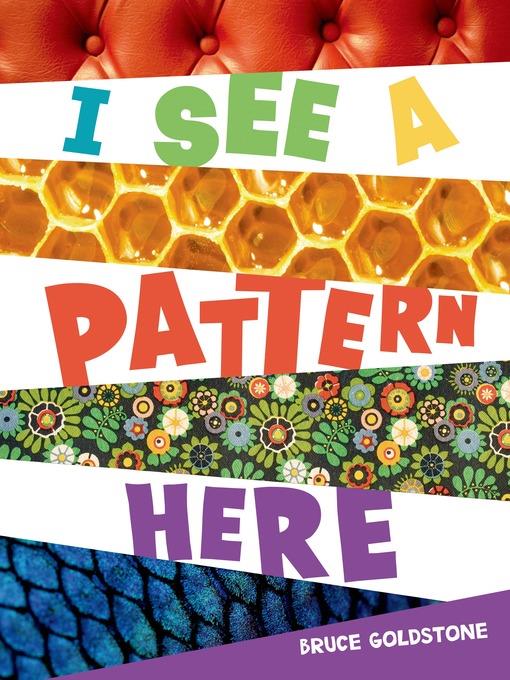
I See a Pattern Here
فرمت کتاب
ebook
تاریخ انتشار
2015
Lexile Score
810
Reading Level
3-4
ATOS
4.7
Interest Level
K-3(LG)
نویسنده
Bruce Goldstoneشابک
9781627796101
کتاب های مرتبط
- اطلاعات
- نقد و بررسی
- دیدگاه کاربران
نقد و بررسی

February 23, 2015
Having examined concepts like probability and estimation in previous books, Goldstone gives a thorough primer on the many forms patterns can take, the ways they are constructed, and the places—both natural and manmade—they can be found. Photographs of animals, textiles, architectural details, and more demonstrate different types of patterns, which Goldstone unpacks in direct, accessible language, as well as in “MathSpeak” sidebars that explain how rotation, scaling, and movement can establish patterns (“A tessellation covers a flat area with one or more shapes, leaving no overlaps and no gaps”). Readers will be hard pressed not to search for patterns everywhere they look after finishing this one. Ages 7–10.

January 1, 2015
Goldstone tackles slides, turns, flips and folds in his latest, a look at patterning.Beginning with the basic example of repeating elements to define a pattern, Goldstone involves readers right from the start by asking them to complete eight basic patterns made with beads on a string (there is an answer key in the back). He then branches out, describing the many ways patterns can be formed, using basic vocabulary in the paragraphs but including "MathSpeak" speech bubbles at the bottoms of the spreads to introduce readers to the real mathematical terms: translation, rotation, 180-degree turn, reflection, symmetry, scaling, tessellation and transformation. Goldstone's examples and photos are a mix of modern (a brick wall), natural (a honeycomb), world cultural (Malinese mud cloth) and historical (a Peruvian cloak), and he ingeniously uses them to clearly illustrate each of the patterning concepts; readers are likely to find patterns everywhere they look in their homes and communities. A final bright spread depicts a mosaic and challenges readers to find examples of each kind of patterning presented in the book. The backmatter gives children some ideas for creating their own patterns with plastic blocks, stamps and paper cutouts. A solid resource for both introducing and reinforcing patterns. (Informational picture book. 7-10)
COPYRIGHT(2015) Kirkus Reviews, ALL RIGHTS RESERVED.

December 1, 2014
Gr 2-4-This attractive picture book is a colorful addition for general collections but can be used to expand a math or social studies library. Relying on a conversational tone and using relatable examples from a wide variety of cultures, the author draws in readers easily as he discusses concepts related to patterns while also tying in social studies, nature, and math vocabulary. Strategically placed questions ("What flips can you find in these patterns?") will engage kids further (an answer key is included at the end). Children are introduced to a wide variety of concepts: math-related ones, such as symmetry and reflection, as well as those that are tied to specific cultures-African mud cloths or the Pantheon's dome in Rome. Bold, striking photographs of everyday objects, such as tiles, mosaics, bee hives, animals, cars, cathedrals, and seashells are used to support the text. Informational text boxes titled "MathSpeak" provide greater detail throughout on topics such as symmetry and scaling. An excellent overview.-Tracey Wong, P.S. 54/Fordham Bedford Academy, Bronx, NY
Copyright 2014 School Library Journal, LLC Used with permission.

February 1, 2015
Grades 2-5 This colorful book challenges readers to recognize patterns and to notice how they differ from one another. Using examples that include everyday objects, animals, and architectural elements, the text points out and briefly explains elements of patternmaking, such as translation, rotation, reflection, symmetry, scaling, and tessellation. Helpful photos illustrate patterns seen in the natural world and a variety of world cultures, from the hexagonal cells in a bee's hive to a mud cloth made in Mali to an ancient Greek tile mosaic. As in his previous math-themed books, including Great Estimations (2006), 100 Ways to Celebrate 100 Days (2010), and That's a Possibility! (2013), Goldstone shot many of the clearly reproduced color photographs that illustrate the concepts. Simplicity, order, and variety in layout give the book an inviting look. The final pages challenge readers to create their own patterns using plastic, interlocking blocks, hand-printed stamps on paper, or paper cutouts. A useful, attractive introduction to patterns.(Reprinted with permission of Booklist, copyright 2015, American Library Association.)

























دیدگاه کاربران